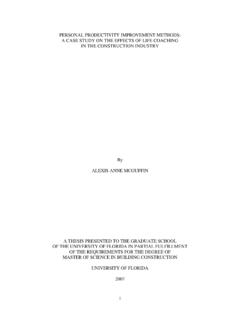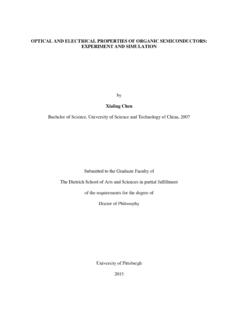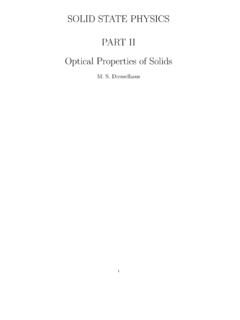Transcription of MAGNETO-OPTICAL PROPERTIES OF NARROW-GAP …
1 MAGNETO-OPTICAL PROPERTIES OF NARROW-GAP SEMICONDUCTORHETEROSTRUCTURESByXINGYUAN PANA DISSERTATION PRESENTED TO THE GRADUATE SCHOOLOF THE UNIVERSITY OF FLORIDA IN PARTIAL FULFILLMENTOF THE REQUIREMENTS FOR THE DEGREE OFDOCTOR OF PHILOSOPHYUNIVERSITY OF FLORIDA2010c 2010 Xingyuan Pan2I dedicate this to my wife, Shuyang Gu, and my would like to thank my thesis advisor, Dr. Christopher Stanton for his consistentsupporting and advising during my graduate study. His insight in condensed matterphysics always help me a lot whenever I was in trouble during my research. I alsolearned a lot on how to be a scientist from his professional attitude towards scientificresearch. I cannot forget those numerous hours we spent together in his office,discussing all kinds of physics problem in general, and my graduate research onsemiconductor physics in also like to thank my supervisory committee members,Dr.
2 David Reitze,Dr. Pradeep Kumar, Dr. Hai-Ping Cheng and Dr. Cammy Abernathy, for spending theirvaluable time on reviewing my proposal for my qualifying exam, and on reviewingmy manuscript for this are also several colleagues I want to thank. Dr. Gary Sanders helpedme a lot during my graduate research, especially when I met some difficulties in thecoding using Fortran programming language. He always triedhis best to help melocate the bug. I also like to thank David Hansen and Brent Nelson for their support incomputer related problems. I would like to thank our collaborators Dr. Sophia Hayesin St. Louis, and Dr. Mike Santos and Dr. Ryan Doezema in Oklahoma, for providingthe experimental data. I want to thank Ms. Kristin Nichola for her help during my stayhere, and I also like to thank all my friends in Gainesville. Last I want to thank my wife,Shuyang Gu, and my parents.
3 Their love are always the best support to OF CONTENTS pageACKNOWLEDGMENTS..4 LIST OF TABLES..7 LIST OF FIGURES..8 ABSTRACT..10 CHAPTER1 INTRODUCTION..122 THEORY.. pMethod.. Spin-Orbit Interaction.. L owdin s Perturbation Theory..183 BAND STRUCTURE OF III-V SEMICONDUCTOR MATERIALS.. Unperturbed Problem Basis Functions.. pPerturbation Without Coupling to Distant Bands.. Coupling to Distant Bands..334 LANDAU LEVELS OF GALLIUM ARSENIDE.. The Envelope Function Approximation.. Explicit Form of the EFA Hamiltonian.. Landau Hamiltonian.. Zeeman Hamiltonian.. Energy and Envelope Functions.. Numerical Calculations of the GaAs Landau Levels.. MAGNETO-OPTICAL Absorption.. Spin-Polarized Absorption and Optically Pumped NMR..595 MAGNETO- PROPERTIES OF INDIUM ANTIMONIDE QUANTUME WELLS.. Experimental Details.. Extension of the Theoretical Model.
4 narrow Energy Gap.. Strain Effect.. Quantum Confinement Effect.. MAGNETO-OPTICAL Absorption.. Results and Discussion..9356 CONCLUSIONS AND FUTURE DIRECTIONS.. Conclusions.. Future Directions.. Exciton Absorption.. Beyond the Axial Approximation.. Carrier Dynamics..107 REFERENCES..109 BIOGRAPHICAL SKETCH..1126 LIST OF TABLEST ablepage1-1 Electron effective mass andg-factor of GaAs, InAs and InSb..134-1 Percentage probability of the zone center wave functions at ..624-2 Percentage probability of the zone center wave functions at ..644-3 Selection rules..667 LIST OF FIGURESF igurepage4-1 Energy band structure for GaAs atB= ..664-2 Energy band structure for GaAs atB= ..674-3 Valence band structure for ..684-4 Valence band structure for ..694-5 Wave function components vs Landau level quantum numberat.
5 704-6 Wave function components vs Landau level quantum numberat ..714-7 Spin dependent absorption for B= ( +polarization)..724-8 Spin dependent absorption for B= ( polarization)..734-9 Spin dependent absorption for B= ( +polarization)..744-10 Spin dependent absorption for B= ( polarization)..754-11 Active components for absorption at B= ( +polarization)..764-12 Active components for absorption at B= ( polarization)..774-13 Active components for absorption at B= ( +polarization)..784-14 Active components for absorption at B= ( polarization)..794-15 Calculated absorption compared with experiments..804-16 OPNMR signal intensity as a function of photon energy for excitation..814-17 OPNMR signal intensity as a function of photon energy for +excitation..824-18 First 6 manifolds of Landau levels at ..834-19 Spin-up and spin-down absorption for light at.
6 844-20 Comparison between OPNMR spectra with calculated spinpolarization..855-1 Sample structure and experimental setup..985-2 Band diagram for an InSb/AlInSb multiple quantum well..985-3 Absorption spectra waterfall plot..995-4 MQW spectra for B=6T..1005-5 MQW fan diagram..10185-6 MQW eigenfunctions at B=6T..1025-7 Absorption with different polarization..1039 Abstract of Dissertation Presented to the Graduate Schoolof the University of Florida in Partial Fulfillment of theRequirements for the Degree of Doctor of PhilosophyMAGNETO- optical PROPERTIES OF NARROW-GAP SEMICONDUCTORHETEROSTRUCTURESByXingyuan PanDecember 2010 Chair: Christopher StantonMajor: PhysicsNext generation of semiconductor device will not only basedon the charge transportproperties of the carrier, but also their spin degree of freedom. In order to understandor predict how those devices work one need to understand the spin-dependentelectronic structures of both bulk and low-dimensional semiconductors .
7 We havetheoretically studied the spin-dependent Landau levels for electrons or holes inbulk GaAs system and AlInSb/InSb multiple quantum wells system. We use theenvelope function approximation for the electronic and MAGNETO-OPTICAL propertiesof AlInSb/InSb superlattices. Our model includes the conduction electrons, heavyholes, light holes and the split-off holes for a total of 8 bands when spin is taken intoaccount. It is a generalization of the Pidgeon-Brown model to include the wave vectordependence of the electronic states, as well as quantization of wave vector due tomultiple quantum well superlattice effects. In addition, we take strain effects into accountby assuming pseudomorphic growth conditions. For bulk GaAssystem, we calculatedthe spin-dependent absorption coefficients which can be directly compared with theoptically pumped NMR experiment.
8 We show that the opticallypumped NMR is acomplimentary tool to traditional magneto optical absorption measurement, in the sensethat optically pumped NMR is more sensitive to the light holetransitions which are veryhard to resolve in the traditional magneto absorption measurement. For the AlInSb/InSbmultiple quantum well system, we calculated both the magneto absorption spectra and10the cyclotron resonance spectra. We compare both spectra toexperimental results andachieve a good agreement. This agreement assures us that ourunderstanding of thevalence band structure of the narrow gap InSb materials are 1 INTRODUCTIONU nderstanding the electronic, transport and optical PROPERTIES of real materialsenable us to utilize the unique PROPERTIES of each material to make devices of these PROPERTIES are closely related to the electronic structures.
9 Nowadayscertain experimental tools can be used to probe the electronic structures, for example,the de Haas-van Alphen effect is a very useful tool to probe the Fermi surface for example is using the MAGNETO-OPTICAL absorption toprobe the Landau levels forsemiconductors, or using cyclotron resonance measurementto probe the effective masstensor. From all these available experimental tools we found that magnetic field is veryimportant in studying the electronic structures. Theoretically we also want to model theelectronic structures of materials in the magnetic field. Because the materials we areinterested in are direct-gap semiconductors , and we are only interested in a very smallrange of the Brillouin zone around the zone center, thek pmethod is most suitablehere for our fact that the solid can be categorized into metals, insulators and semiconductorsis based on its electronic structure.
10 Metals do not have a band gap, insulators have alarge band gap and semiconductors usually have a band gap less than 4 electron types of electronic devices are designed based on the semiconductors materialsand it is fair to say semiconductor materials are the basis ofthe modern electronicindustry. At this time the most important and most famous semiconductor is silicon, notonly because of its PROPERTIES but also because its manufacture is so mature that thecost is low compared with other materials. However, III-V semiconductors also foundthemselves important device applications. Wide bandgap semiconductors such as GaNfind their applications in light-emitting diodes (LEDs), lasers and detectors in the visibleand ultraviolet range. At the other end, narrow bandgap III-V semiconductors have someunique PROPERTIES that can be used in a number of electronic devices[1 3].



















